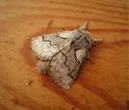
Harmful Effects of Goat moth
A species of Cosmotriche
Goat moth poses risks to oak trees by consuming their leaves, leading to defoliation and impaired photosynthesis. This can result in stunted growth, weakened health, and heightened vulnerability to additional stressors.
What Type of Pest Is Goat moth?









AI entomologist in your pocket
Scan QR code to download

